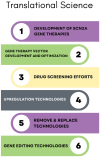A patient organization perspective: charting the course to a cure for SCN2A-related disorders
- PMID: 39533986
- PMCID: PMC11555743
- DOI: 10.1177/26330040241292645
A patient organization perspective: charting the course to a cure for SCN2A-related disorders
Abstract
The SCN2A gene encodes the Nav1.2 protein, a voltage-gated sodium channel crucial for initiating and transmitting action potentials in neurons. Dysfunction in Nav1.2, often stemming from genetic mutations in the SCN2A gene, leads to SCN2A-related disorders. Individuals harboring pathogenic SCN2A variants present with severe neurodevelopmental disorders such as epilepsy, autism spectrum disorders, movement disorders, cortical visual impairment, and intellectual disabilities. The FamilieSCN2A Foundation, a 501(c)(3) patient advocacy organization, is dedicated to enhancing the lives of those affected by SCN2A-related disorders. Fueled by a vision of a world with effective treatments and cures for all patients with SCN2A-related disorders, FamilieSCN2A Foundation has charted the course to a cure based on their core values of urgency, integrity, collaboration, and inclusion. Their strategic plan centers on building a comprehensive research-readiness infrastructure that maximizes the probability of bringing curative therapies to SCN2A patients. Appreciating that statistically most drug development initiatives will fail, creating an infrastructure that maximizes the number of drugs in development for SCN2A-related disorders in turn maximizes the net probability of success that FamilieSCN2A Foundation will achieving their vision. Through dynamic initiatives and notable achievements, including raising ~$6 million USD, funding 26 research grants totaling ~$4.7 million USD, and forging strategic partnerships across the SCN2A-related disorder ecosystem the foundation is actively executing its strategic plan. With SCN2A research advancing rapidly and a thriving ecosystem of diverse, engaged stakeholders, FamilieSCN2A Foundation believes the outlook for SCN2A-related disorders is bright.
Keywords: Nav1.2; SCN2A; autism; epilepsy; roadmap.
Plain language summary
A patient organization perspective: charting the course to a cure for SCN2A-Related Disorders Advances in gene discovery for neurodevelopmental disorders have identified SCN2A as a leading cause of early-onset epilepsy, autism spectrum disorder, and intellectual disability. SCN2A encodes a neuronal voltage-gated sodium channel, Nav1.2. Pathogenic genetic variants in SCN2A disrupt the normal flow of sodium ions in the brain and disrupt a neuron’s ability to generate and transmit electrical signals. The spectrum of symptoms and severity in SCN2A-related disorders is broad and can lead to epilepsy, autism, movement disorders, visual impairment, and intellectual disabilities. There is currently no cure for SCN2A-related disorders. The FamilieSCN2A Foundation is a non-profit organization committed to improving the lives of those affected by SCN2A-related disorders and working towards a cure. The foundation focuses on building a research-ready ecosystem to increase the success of new and ongoing drug development efforts. The foundation is actively working towards this goal by building an educated and empowered patient community and raising funds to support basic and translational research projects and natural history. With the field advancing and a growing network of involved supporters, FamilieSCN2A Foundation is optimistic about the future of SCN2A-related disorders.
© The Author(s), 2024.
Conflict of interest statement
The authors declare that there is no conflict of interest.
Figures









Similar articles
-
Expanded clinical phenotype spectrum correlates with variant function in SCN2A-related disorders.Brain. 2024 Aug 1;147(8):2761-2774. doi: 10.1093/brain/awae125. Brain. 2024. PMID: 38651838 Free PMC article.
-
Pathogenic SCN2A variants cause early-stage dysfunction in patient-derived neurons.Hum Mol Genet. 2023 Jun 19;32(13):2192-2204. doi: 10.1093/hmg/ddad048. Hum Mol Genet. 2023. PMID: 37010102 Free PMC article.
-
Developing a pathway to clinical trials for CACNA1A-related epilepsies: A patient organization perspective.Ther Adv Rare Dis. 2024 Apr 25;5:26330040241245725. doi: 10.1177/26330040241245725. eCollection 2024 Jan-Dec. Ther Adv Rare Dis. 2024. PMID: 38681799 Free PMC article. Review.
-
Progress in Understanding and Treating SCN2A-Mediated Disorders.Trends Neurosci. 2018 Jul;41(7):442-456. doi: 10.1016/j.tins.2018.03.011. Epub 2018 Apr 23. Trends Neurosci. 2018. PMID: 29691040 Free PMC article. Review.
-
Hyperexcitability in adult mice with severe deficiency in NaV1.2 channels.Int J Physiol Pathophysiol Pharmacol. 2022 Feb 15;14(1):55-59. eCollection 2022. Int J Physiol Pathophysiol Pharmacol. 2022. PMID: 35310859 Free PMC article.
Cited by
-
Decoding SCN2A Variants: Bridging Genetics and Phenotypes in Autism Spectrum Disorder.J Clin Med. 2025 May 28;14(11):3790. doi: 10.3390/jcm14113790. J Clin Med. 2025. PMID: 40507552 Free PMC article. Review.
References
-
- Bean BP. The action potential in mammalian central neurons. Nat Rev Neurosci 2007; 8: 451–465. - PubMed
-
- Hedrich UBS, Lauxmann S, Lerche H. SCN2A channelopathies: mechanisms and models. Epilepsia 2019; 60(Suppl. 3): S68–S76. - PubMed
-
- Wolff M, Brunklaus A, Zuberi SM. Phenotypic spectrum and genetics of SCN2A-related disorders, treatment options, and outcomes in epilepsy and beyond. Epilepsia 2019; 60(Suppl. 3): S59–S67. - PubMed
-
- Lauxmann S, Verbeek NE, Liu Y, et al.. Relationship of electrophysiological dysfunction and clinical severity in SCN2A-related epilepsies. Hum Mutat 2018; 39: 1942–1956. - PubMed
-
- Wolff M, Johannesen KM, Hedrich UBS, et al.. Genetic and phenotypic heterogeneity suggest therapeutic implications in SCN2A-related disorders. Brain 2017; 140: 1316–1336. - PubMed
Publication types
LinkOut - more resources
Full Text Sources
